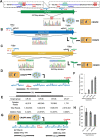Efficient large fragment deletion in plants: double pairs of sgRNAs are better than dual sgRNAs
- PMID: 37841500
- PMCID: PMC10569238
- DOI: 10.1093/hr/uhad168
Efficient large fragment deletion in plants: double pairs of sgRNAs are better than dual sgRNAs
Figures

Similar articles
-
Establishment of CRISPR/Cas9 Genome-Editing System Based on Dual sgRNAs in Flammulina filiformis.J Fungi (Basel). 2022 Jun 30;8(7):693. doi: 10.3390/jof8070693. J Fungi (Basel). 2022. PMID: 35887449 Free PMC article.
-
An efficient CRISPR/Cas9 system for simultaneous editing two target sites in Fortunella hindsii.Hortic Res. 2022 Mar 14;9:uhac064. doi: 10.1093/hr/uhac064. eCollection 2022. Hortic Res. 2022. PMID: 35673604 Free PMC article.
-
Efficient CRISPR/Cas9 mediated Pooled-sgRNAs assembly accelerates targeting multiple genes related to male sterility in cotton.Plant Methods. 2021 Feb 8;17(1):16. doi: 10.1186/s13007-021-00712-x. Plant Methods. 2021. PMID: 33557889 Free PMC article.
-
Effects of sgRNAs, Promoters, and Explants on the Gene Editing Efficiency of the CRISPR/Cas9 System in Chinese Kale.Int J Mol Sci. 2023 Aug 26;24(17):13241. doi: 10.3390/ijms241713241. Int J Mol Sci. 2023. PMID: 37686051 Free PMC article.
-
Genome Editing in Cotton with the CRISPR/Cas9 System.Front Plant Sci. 2017 Aug 3;8:1364. doi: 10.3389/fpls.2017.01364. eCollection 2017. Front Plant Sci. 2017. PMID: 28824692 Free PMC article.
References
-
- Wang Y, Geng L, Yuan Met al. . Deletion of a target gene in Indica rice via CRISPR/Cas9. Plant Cell Rep. 2017;36:1333–43 - PubMed
LinkOut - more resources
Full Text Sources

